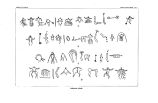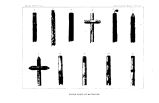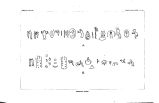| OCR Text |
Show OF THE BUREAU OP ETHNOLOGY. XXIII chambers to another was by the outside. Many of the chambers had evidently been occupied as dwellings. They still contained fireplaces and evidences of fire; there were little caverns or shelves in which various vessels were placed, and many evidences of the handicraft of the people were left in stone, bone, horn, and wood, and in the chambers and about the sides of the cliffs potsherds are abundant. On more careful survey it was found that many chambers had been used as stables for asses, goats, and sheep. Sometimes they had been filled a few inches, or even two or three feet, with the excrement of these animals. Ears of corn and corncobs were also found in many places. Some of the chambers were evidently constructed to be used as storehouses or caches for grain. Altogether it is very evident that the cliff houses have been used in comparatively modern times; at any rate since the people owned asses, goats, and sheep. The rock is of such a friable nature that it will not stand atmospheric degradation very long, and there is abundant evidence of this character testifying to the recent occupancy of these cavate dwellings. Above the cliffs, on the mesas, which have already been described, evidences of more ancient ruins were found. These were pueblos built of cut stone rudely dressed. Every mesa had at least one ancient pueblo upon it, evidently far more ancient than the cavate dwellings found in the face of the cliffs. It is, then, very plain that the cavate dwellings are not of great age; that they have been occupied since the advent of the white man, and that on the summit of the cliffs there are ruins of more ancient pueblos. Now, the pottery of Santa Clara had been previously studied by Mr. Stevenson, who made a large collection there two or three years ago, and it was at once noticed " that the potsherds of these cliff dwellings are, both in shape and material, like those now made by the Santa Clara Indians. The peculiar. pottery of Santa Clara is readily distinguished, as may be seen by examining the collection now in the National Museum. While encamped in the valley below, the party met a Santa Clara Indian and engaged him in conversation. From him the history of the cliff dwellings was soon obtained. His statement was that originally his people lived in six pueblos, built of cut stone, |














































































































































































































































































































































































































